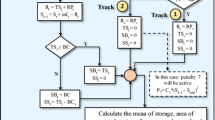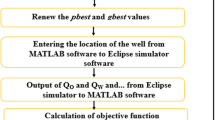Abstract
In this paper the main criteria of the water curtain system for unlined rock caverns (URCs) is described. By the application of numerical modeling and genetic programming (GP), a method for water curtain system pre-design for Iranian crude oil storage URCs (common dimension worldwide) is presented. A comprehensive set of numerical simulations is performed using the finite element based commercial software (COMSOL 5.1) where the results are used as database for genetic programming. Describing equations of water inflow to the filled and empty caverns and water production rate of water curtain boreholes are generated using GP. By equating the proposed equations to each other, water curtain system can be pre-designed. Relative error of the generated GP equations shows their ability and accuracy. Applying a standard regression coefficient method, sensitivity analysis of parameters related to water curtain performance and water inflow to the caverns is performed as well. The results help the design of the water curtain system for crude oil storage caverns worldwide.
Similar content being viewed by others
References
Aberg B (1977) Prevention of gas leakage from unlined reservoirs in rock. In: Proceedings of the international symposium on storage in excavated rock caverns. Stockholm, Sweden, pp 399–413
Butscher C (2012) Steady-state groundwater inflow into a circular tunnel. Tunn Undergr Space Technol 32:158–167. doi:10.1016/j.tust.2012.06.007
Domenico PA, Schwartz FW (1990) Physical and chemical hydrogeology. Wiley, New York
El Tani M (1999) Water inflow into tunnels. In: Proceedings of the World Tunnel Congress ITA-AITES, Oslo, pp 61–70
El Tani M (2003) Circular tunnel in a semi-infinite aquifer. Tunn Undergr Space Technol 18:49–55. doi:10.1016/S0886-7798(02)00102-5
Finsterle S, Ahlers CF, Trautz RC, Cook PJ (2003) Inverse and predictive modeling of seepage into underground openings. J Contam Hydrol 62–63:89–109. doi:10.1016/S0169-7722(02)00174-2
Froise S (1987) Hydrocarbon storage in unlined rock caverns: Norway’s use and experience. Tunn Undergr Space Technol 2:265–268. doi:10.1016/0886-7798(87)90033-2
Ghotbi Ravandi E, Rahmannejad R, Feili Monfared AE, Ghotbi Ravandi E (2013) Application of numerical modeling and genetic programming to estimate rock mass modulus of deformation. Int J Min Sci Technol 23:733–737
Ghotbi Ravandi E, Rahmannejad R, Karimi-Nasab S, Sarrafi A (2016) Sensitivity analysis of effective parameters on water curtain performance for crude oil storage in Iranian URC using the 2k factorial design and numerical modeling. Tunn Undergr Space Technol 58:247–256. doi:10.1016/j.tust.2016.06.001
Glamheden R, Curtis P (2006) Excavation of a cavern for high-pressure storage of natural gas. Tunn Undergr Space Technol 21:56–67. doi:10.1016/j.tust.2005.06.002
Gulraiz Akhter M, Ahmad Z, Khan KA (2006) Excel based finite difference modeling of groundwater flow. J Himal Earth Sci 39:49–53
Haug SM (2007) Storage of oil and gas in rock caverns below the groundwater table-general design development. In: Underground constructions for the Norwegian oil and gas industry. Norwegian Tunnelling Society Publication 16, pp 19–25
Karlsrud K (2001) Water control when tunnelling under urban areas in the Oslo region. NFF Publication, vol 12, pp 27–33
Kjørholt H, Broch E (1992) The water curtain—a successful means of preventing gas leakage from high-pressure, unlined rock caverns. Tunn Undergr Space Technol 7:127–132. doi:10.1016/0886-7798(92)90042-G
Koza J (1976) Genetic programming: on the programming of computers by means of natural selection. MIT Press, Cambridge
Lei S (1999) An analytical solution for steady flow into a tunnel. Ground Water 37:23–26. doi:10.1111/j.1745-6584.1999.tb00953.x
Li Z, Wang K, Wang A, Liu H (2009) Experimental study of water curtain performance for gas storage in an underground cavern. J Rock Mech Geotech Eng 1:89–96. doi:10.3724/SP.J.1235.2009.00089
Liang J, Lindblom U (1994) Analyses of gas storage capacity in unlined rock caverns. Rock Mech Rock Eng 27:115–134
Lombardi G (2002) Private notes
Lu M (2010) Rock engineering problems related to underground hydrocarbon storage. J Rock Mech Geotech Eng 2:289–297. doi:10.3724/SP.J.1235.2010.00289
Midtlien NO (2007) Cavern storage excavation-store. In: Underground constructions for the Norwegian oil and gas industry. Norwegian Tunnelling Society Publication 16, pp 47–56
Muskat M (1937) The flow of homogeneous fluid through porous media. McGraw Hill, New York, pp 175–181
Schleiss AJ (1988) Design of reinforced concrete-lined pressure tunnels. Int Congr Tunn Water Madr 2:1127–1133
Verma KSRK, Vijaya Bhaskar K, Elangovan S (2008) Underground storage—a summary on first Indian cavern for LPG storage. World Tunnel Congress 2008—underground facilities for better environment and safety—India, pp 1024–1036
Wang S, Tokunaga TK (2015) Capillary pressure—saturation relations for supercritical CO2 and brine in limestone/dolomite sands: implications for geologic carbon sequestration in carbonate reservoirs. Environ Sci Technol 49:7208–7217
Wang Z, Li S, Qiao L (2015) Design and test aspects of a water curtain system for underground oil storage caverns in China. Tunn Undergr Space Technol Inc Trenchless Technol Res 48:20–34. doi:10.1016/j.tust.2015.01.009
Acknowledgements
The authors would like to thank Iranian Oil Terminals Company for financial support.
Author information
Authors and Affiliations
Corresponding author
Rights and permissions
About this article
Cite this article
Ghotbi Ravandi, E., Rahmannejad, R., Karimi-Nasab, S. et al. Water Curtain System Pre-design for Crude Oil Storage URCs: A Numerical Modeling and Genetic Programming Approach. Geotech Geol Eng 36, 813–826 (2018). https://doi.org/10.1007/s10706-017-0355-0
Received:
Accepted:
Published:
Issue Date:
DOI: https://doi.org/10.1007/s10706-017-0355-0












